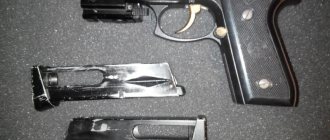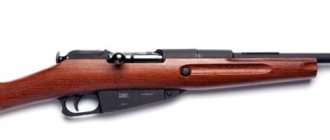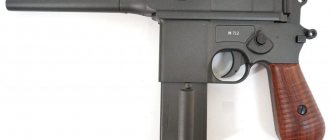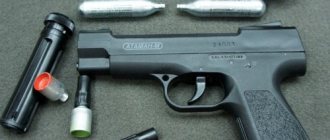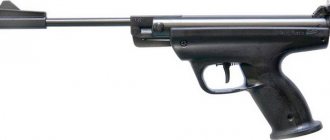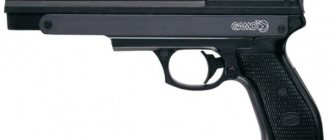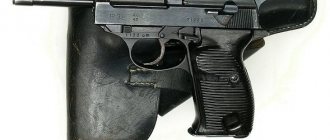The choice of airgun ammunition is a point that rarely gets the attention it deserves. But in vain! After all, the accuracy and result of shooting, the service life and successful operation of the weapon, and in general, let’s not be afraid of this word, your personal safety directly depend on them. Therefore, today we are learning how to choose the right balls and understand the whole variety of assortments on the market.
Balls used for pneumatic shooting are also called explosive shot. They appeared on the market recently - when weapons powered by carbon dioxide appeared with installed bunker-type stores. The advantage of this type of projectile is its rounded shape: the balls are easy to install in the magazine. In addition, a bunker-type magazine does not require a neat ball-to-ball arrangement - they usually use a magnetic system for feeding projectiles, and this rule works for both pneumatic and airsoft weapons. The only difference is that pneumatic guns use metal projectiles, while airsoft guns use plastic balls.
What materials are pneumatic balls made from?
In the world of airguns, BB or .17 caliber pellets are relatively new. This type of ammunition became popular when pistols were released onto the market in which shots began to be fired using CO2 and a rifle with a hopper-type magazine.
The big advantage of this type of ammunition is its shape - the ball is easier to install in a box magazine, and the hopper does not require its placement in a strict orientation in the internal volume, especially since such rifles use magnetic plates to feed the balls. This property is used in both air guns and Airsoft guns. The only difference is that air guns use metal ammunition, while Airsoft guns use plastic.
Today, air guns use metal ammunition of various calibers from 4 mm to 9 mm. For the most common caliber 4.5 mm, two types of metal balls are used - with a steel core and lead balls.
Steel balls are made from wire by molding. A cylindrical piece is pressed into a spherical blank, and then an ideal ball is formed by rolling. Lead balls can be made either by casting or stamping.
After the steel piece is shaped into a spherical shape and has been rolled in a drum, the ammunition goes through the process of applying a protective coating. This technological operation is necessary to protect the steel base from corrosion. Coating with a layer of protective metal ensures long-term safety and presentation of the ball.
Lead ammunition, like conventional bullets, is additionally treated with graphite lubricant. Lead does not require a protective coating; a preservative lubricant is enough for it.
What is the difference between copper-plated bullets and galvanized ones?
Several types of metals are used to provide corrosion protection for bullets. Most often used for this:
- Copper;
- Zinc;
- Nickel;
- Brass;
Brass and nickel are used relatively rarely; the fact is that these metals protect steel well from rust, but compared to zinc and copper they do not have sufficient ductility.
Copper works well on steel. In addition, it is a very ductile metal. When fired, the copper sheath does not damage the barrel rail. When purchasing cartridges of yellow or reddish-yellow color, you need to remember that they have a copper coating.
Zinc plating on a steel core is cheaper than copper plating. Galvanized ammunition lasts longer in packaging and better protects the steel core from moisture. But unlike copper, it is not as ductile. Therefore, they are recommended only for smoothbore weapons that have a brass rail inserted into a steel or aluminum barrel.
Classification of balls by weight
Copper-plated or galvanized balls used as ammunition have approximately equal mass.
For .17 caliber BBs weigh about 0.3-0.33 grams. The difference in weight of this type of bullet is due to the quality of the steel core. The steel core weighs heavier, but the alloy core is lighter.
A lead spherical bullet weighs 0.49-0.51 grams. The shape and size of the ball plays a big role here.
Even within the same package of bullets there can be differences in grams. This situation is explained by the fact that when forming a mold during the rolling process, the production technology is violated. Because of this, the balls turn out to be different in diameter; some specimens have flaws in the form of sagging or a slightly elongated shape.
Today, the weight of explosive bullets with a difference of 0.01-0.05 grams is not critical, since smooth-bore weapons with a CO2 charge are usually used for recreational shooting.
At the same time, it is worth noting that a number of weapons use a rather rare caliber - 4.4 mm. For these rifles (mostly the Haenel Suhl 310 model made in the GDR - a bolt-loading repeating rifle) lead ammunition weighing 0.42-0.43 grams is still produced.
Types of airsoft balls
Color
The vast majority of players use standard white plastic balls. They are generally accepted and widely distributed.
However, airsoft balls can be not only white, but for example, black, pink, gray, brown, green, red. The difference in the color of the ball is mainly intended to bring variety to the gameplay.
Tracer balls
To achieve the effect of a tracer fight, the balls are mixed with a special light-accumulating fluorescent pigment. In combination with a special attachment on the barrel that “charges” the jacking balls with light, you can get the effect of a fireworks display of luminous balls.
Bio balls
Special balls that decompose by microorganisms. If they fall into the ground, they will completely decompose after some time.
Classification by caliber
Like other types of airgun bullets, spherical bullets are available in several calibers.
The most common caliber is 4.5 mm. In some Western classifications, this caliber is called explosive, like shot for hunting firearms. The name of the explosive itself is associated with a shot whose diameter is 0.18 inches. In terms of the metric system, this figure is 4.57 mm. In the American classification system for steel shot, the caliber of explosives is precisely 0.18 inches. True, steel shot cannot in any way be used as bullets for air guns.
Spherical bullets are used as a sub-caliber type of ammunition, which means that its diameter must be smaller than the diameter of the bore. Copper-plated or galvanized BB class balls are produced with a diameter of 4.35-4.44 mm.
Lead spherical bullets are available for all calibers of air guns.
Among the calibers are small calibers 4 mm, 4.5 mm, medium calibers - 5.5 mm, 6 mm, large calibers - 7.62 and 7.65 mm, 8 and even 9 mm. But, except for the most common caliber 4.5 mm, all other types of lead spherical bullets are rather the exception to the rule.
Which pneumatic balls are better?
The choice of bullets for pneumatics depends mainly on the characteristics of the weapon. The main issue in using this or that type of ball here is the rationality of using ammunition. For weapons with a caliber of 4.5 mm, copper-plated or galvanized steel ammunition has found its use in smooth-bore systems and in samples with a bunker type magazine. Lead bullets have found greater use for rifled barrels.
This difference is due to the fact that steel balls are used as sub-caliber ammunition. When passing through the bore, the ball does not receive rotational motion. It is simply pushed out by compressed air or CO2. In smoothbore weapons, unlike rifled ones, the inside of the barrel is brass or bronze. In models with a rifled barrel, the entire barrel is made of steel. A copper-plated or galvanized ball, passing through the channel, despite the layer of soft metal, is not able to fit tightly into the rifling, which is why the rifling will be constantly exposed to the steel core.
A lead bullet is another matter. For rifles and pistols with a rifled barrel, lead, under the influence of air or CO2, enters the rifling and, passing through the channel, acquires a rotational movement, like ordinary lead bullets. But with smooth-bore pistols and rifles, things are different - a heavy lead ball will require great effort to fire. This state of affairs leads to high gas consumption, wear of cuffs and valve seals.
For smooth-bore pistols and rifles with a hopper-type magazine, galvanized or copper-plated steel balls are preferable. For rifled rifles and pistols, it is better to use lead spherical bullets.
What is better - bullets or balls
When comparing spherical ammunition and standard bullets, it should be noted that under the same conditions for firing a shot, the result will be different. To assess the difference between balls and bullets, it is worth taking the following parameters for analysis:
- bullet flight speed at different parts of the trajectory;
- trajectory curvature;
- ballistic characteristics of ammunition;
- accuracy of fire;
- damaging and ricocheting properties.
For the analysis, equal conditions are taken - bullet weight, initial flight speed, weapons with the same muzzle energy.
| Properties | Copper-plated (galvanized) steel balls | Standard lead airgun bullets |
| Bullet speed | When shooting from a smooth-bore weapon, the balls show different results. The spread of the result can be from 5 to 10 m/s. For a rifled sample, the difference in speed is not so significant, but it still exists. | When shooting from smooth-bore weapons, unstable results are shown. For rifled weapons, the result is stable, the performance is higher than that of balls by 5-10 m/s. |
| Path curvature | A sharp decrease in trajectory with loss of flight speed | The flight path is characterized by a gradual decrease |
| Range of flight | Under standard conditions, the flight range is estimated at 20-25 meters. The effective firing range at the target is estimated at 8-10 meters. | Ensures target destruction at a distance of 30-45 meters. The effective firing range at the target is within 15-25 meters. |
| Ballistic characteristics | Characterized by high aerodynamic drag, a sharp loss of speed, and a tendency to be blown away by side wind flow | Has stable aerodynamic properties. Maintains rotational motion for a long time, with little exposure to wind at the initial stage of flight. |
| Firing accuracy | When firing from all types of weapons, the accuracy is unsatisfactory. The only use is for recreational shooting at short distances. | Excellent accuracy, allowing the bullets to be used for training, sporting competitions and hunting |
| Damaging properties | Due to the large frontal area of the bullet and the lack of rotational movement, it has little penetrating power. | Good penetrating qualities |
| Tendency to ricochet | High | Low (except models with steel core and round head shape) |
Now that the main points related to the ballistic properties of ball ammunition have been revealed, it becomes obvious whether balls or bullets are better - there is no clear assessment. The advantages of one type of ammunition over another does not reflect the full picture.
First of all, the purpose of copper-plated and galvanized balls and their suitability for a specific type of weapon should be assessed. For air pistols with a smooth-bore rail in the barrel, steel balls are the best type of ammunition - they are most suitable in caliber, weight and shape. For this class of pistols, a lead ball, despite the ability to load a pistol magazine with this ammunition, is not a very good choice - when fired, lead balls require more gas pressure, which means that the valve assembly experiences high pressure. When loading, there are often cases when the lead sphere is deformed, as a result of which, when fired, the risk of the ball being skewed and the bore being deformed increases. In addition, when fired, a lead ball passing through the channel leaves a mark on the walls, which also negatively affects the condition of the weapon; the barrel requires careful cleaning and the use of chemicals to remove lead deposits.
The use of conventional lead bullets in such models of pistols is also not advisable, since the design of the magazine itself is not intended for the use of this type of ammunition.
For rifles, especially those with a hopper magazine, despite the fact that manufacturers recommend using galvanized steel or copper-plated balls, firing these ammunition results in rapid barrel failure. The steel does not have the ductility to conform to the rifling of the barrel, and the layer of zinc or copper is too thin to allow the ammunition to pass properly through the bore.
Thus, we can conclude that galvanized and copper-plated steel balls are a special type of bullets for smooth-bore pneumatic weapons and cannot compete with lead bullets for rifled weapons.
Projectiles for air guns
Projectiles for air guns are divided into the following groups: pellets - lead bullets of various weights and shapes, balls (BB"s) - steel balls with a diameter of 4.4 mm, arrows (Bolts) - steel arrows with hard plastic tails, darts ( Darts) - steel or brass arrows with tassel-shaped feathers, plastic balls with a diameter of 6 mm for “soft pneumatics”. For calibers greater than 4.5 mm, only bullets are used.
1.
Bolts and Darts
Bolts and darts are arrow-shaped bullets with a stabilizer. The arrows are a sub-caliber needle with a plastic stabilizer. The dart is also a sub-caliber needle with a tail in the form of a brush made of bristles, threads or feathers made of hard plastic. Arrows and darts are reusable projectiles (up to 70 times) designed for recreational shooting. Their accuracy and speed are satisfactory at distances less than ten meters, but they are more expensive than other types of bullets and wear out the barrel more. The fact is that plastic, or even more so, thread tails are capable of collecting various dust or even grains of sand, and when moving along the barrel, the grains of sand have an abrasive effect on it, erasing the rifling and creating a funnel-type expansion of the barrel towards the barrel.
2.
Balls (BB”s)
In this case, the balls are steel spherical bullets weighing 0.35 g for pneumatic weapons of 4.4 mm caliber. Many shooters and manufacturers call spherical steel bullets - BB, or, in Russian, “babeshka”. This name comes from the environment of firearms for hunting smoothbore weapons. According to the English (American) classification, a shot with a diameter of 0.18 inches (4.572 mm) is called “BB”. Accordingly, B is 0.17 inches, BBB is 0.19 inches. Since the caliber of pneumatic weapons is 4.5 mm (0.177 inches), lead spherical bullets for pneumatics began to be called also - BB. In fact, this is what they were: the diameter of bullets for a 4.5 mm rifled barrel is 4.6-4.7 mm. Steel balls appeared much later and were already sub-caliber - approximately 4.4 mm, but the name explosive was firmly attached to them. By the way, explosive steel shot is also produced in the USA. Its diameter is exactly 0.18 inches, therefore, it is not interchangeable with steel explosive balls for pneumatics.
The reason for the widespread use of balls was the ease of designing stores and the ability to secure the ball from falling out using a magnet, as well as low requirements for shooting accuracy. The balls can be shiny, uncoated, or copper-plated, reddish in color, or galvanized, whitish. Uncoated balls tend to rust quite often; the coating sometimes peels off from galvanized ones, and they rust too. Air gun barrels are not chrome-plated, so rust not only contaminates the barrel and reduces the already low accuracy of the shot, but also contributes to the corrosion of the weapon. Zinc oxidation products are harder than the metal of barrels and scratch them, not to mention the plastic parts of magazines. Copper-plated balls do not oxidize or flake off, but it is still worth adding a drop of gun oil into their packaging.
The diameter of the balls is smaller than 4.5 mm caliber and is usually equal to 4.4 mm in order for the balls to pass through rifled barrels (i.e., essentially, sub-caliber ammunition). Some unscrupulous sellers, who slyly recommend balls for any pneumatic gun, like to say that the ball flies on the so-called “gas lubrication”, almost without touching the barrel, and does not damage it. But the ball flies along the rifled barrel with oscillations, since the gas flow between the ball and the rifling does not provide sufficient distance between the ball and the rifling and the edges of the rifling are broken. In this case, not only the rifling is “killed”, but also the accuracy of fire is reduced, and the breakthrough of air forward of the ball reduces the accuracy even more. Therefore, you cannot shoot balls from any rifled barrels; steel barrels of inexpensive domestic weapons can withstand such mockery of weapons to a certain extent. But quite a lot of foreign models are produced (Benjamen Sheridan, Daisy, Crosman) with brass (lined) barrels.
Even if the instructions for a pistol with a rifled barrel indicate that it can shoot both bullets and balls, do not load the balls, even if they are copper-plated or gold-plated. Another big drawback is their greatest tendency to ricochet, and due to the hardness of the ball (compared to lead, for example), the energy after a ricochet almost does not decrease, unlike bullets, which, when they hit a solid obstacle (metal, concrete), are deformed and lose energy. Of course, some smooth-bore pistols can also be loaded with bullets, but when they fly out of a smooth barrel, the bullets begin to tumble and arrive at the target on a random side or completely miss the target.
The steel ball is very hard, does not experience significant deformation when hitting a target and therefore, all other things being equal, is the best means for piercing targets such as bottles and cans. Which is what is required of him.
When purchasing copper-plated steel balls for recreational airgun shooting, many airgunners and hobbyists usually pay attention to just two things. This is the price for a certain quantity and ease of use of the packaging. They rarely look at the name of the manufacturer - the balls are all the same, why bother or pay more? And the name may not say anything. Well, balls called “Anike” are familiar from this company’s shooting products of the same name, but almost no one knows what Vector LLC is, except, perhaps, the manufacturer itself.
Although, the manufacturer still identified itself: when you take the package in your hands, you can see raised letters on the transparent blister: GPZ 21. This immediately changes the matter, because the balls are produced at any GPZ. with the quality control stamp, even if rejected for use in bearings, have such even and stable characteristics in diameter, material of manufacture and weight that these readings can be considered close to ideal. Especially for recreational shooting with short-barreled air guns. Coated with a layer of yellow-red copper, all the balls, without exception, have a diameter of 4.46 mm. The cleanliness of their surface is worthy of the highest mark. For example, the balls of Vector LLC have much more stable parameters and quality compared to the balls from Anike. But the quality of the balls of the American company Copperhead does not stand up to criticism. Curved, potholed balls from the USA are only suitable for aimless shooting at dusk. In comparison, Anike balls range in diameter from 4.43 to 4.45 mm, and Copperhead balls range from 4.39 to 4.43 mm in diameter.
When shooting with steel balls produced by Vector LLC with such stable parameters, one cannot expect separation and poor accuracy. So, from 10 meters, balls fired from the MP-654 (modified) consistently hit the larger side of the matchbox. At 5 meters, the same MP-654 with Vector LLC balls is capable of showing an accuracy of 15 mm, which is quite enough for this pistol and recreational shooting.
3.
Pellets
There are many bullets for rifled pneumatic weapons. They differ in shape, caliber, purpose, manufacturing method, material, quality and, of course, price.
Of the usual calibers - . 177 - 4.5 mm, .20 - 5.0 mm, .22 - 5.5 mm and .25 - 6.35 mm - the most common caliber is 4.5 mm, then 5.5 mm. Most 4.5 mm bullets have a mass in the range of 0.45-0.58 g (standard value 6.51 g). Compared to 5.5 mm and 6.35 mm bullets, they have a flatter trajectory at all real shooting distances and a smaller drop in velocities as they move away from the muzzle, which ensures higher shooting accuracy at extreme distances, as well as better penetration action.
Bullets of 5.0 mm caliber predominantly have a mass in the range of 0.58-0.75 g, bullets of 5.5 mm caliber - a mass of 0.84-0.91 g (standard value 0.91 g), bullets of 6.35 mm caliber - weight 1.1 -1.56 g. Compared to 4.5 mm bullets, they have a lower initial speed, which is why the flatness of their trajectory is worse, but at the same time, due to the larger mass of the bullet, wind drift is also reduced. Due to their larger cross-section and mass, the 5.5mm and 6.35mm bullets produce a stronger shock and are better suited for hunting.
Weapons are also produced abroad for bullets (you can’t call them bullets anymore!) of very significant calibers - 7.62 mm (the GC2 rifle from Sportsmatch with a muzzle energy of 54 J) and even 9 mm!
Based on the shape of the bullet, it can be divided into three types: cylindrical (cup, cap, pointed ones are called cylindrical-conical), round (spherical) and the “diabalo” type - the most common type of lead bullets, in general form it is a “coil” of two connected by truncated vertices cones.
Based on the manufacturing method, they are trying to divide bullets into cast and stamped, although bullets for small calibers are not cast. For calibers like 4.5 mm, 5.0 mm and 5.5 mm, this is unproductive, and the quality will be low, and the equipment will be unreasonably complex and expensive.
The quality of bullets for air guns must be very high - the slightest deviation in weight or shape of bullets from each other inevitably leads to an increase in dispersion, and consequently, the probability of a miss increases sharply. Therefore, for target shooting and hunting, it is advisable to use the highest quality bullets from well-known manufacturers: Crosman, Beeman, Haendler & Natermann, RWS, and others. Bullets from Gamo and Copperhead are simpler, they have a larger spread (but lower price), but they can also be used for hunting. Bullets produced somewhere in Asia do not meet quality requirements and are not advisable to use for critical shots.
Until relatively recently, bullets were made exclusively from lead and lead-dominated alloys. Nowadays it is no longer uncommon to find hunting bullets with a metal (steel) head and a plastic body (Prometheus, Wilhter High Power, Walther Stell Point, Scarabey Magnum, etc.).
Each gun has its own characteristics and “favorite” or “unfavorite” bullets. There are “omnivorous” guns, but this is rare; more often guns shoot well only with certain bullets of one or another, i.e. the spread is simply outrageous. Therefore, every serious shooter faces the problem of selecting bullets for his gun. It is difficult to give specific recommendations, but you should know that the use of certain types of bullets depends, first of all, on the initial speed that the gun gives them. (The vast majority of pneumatics operate at subsonic (90-300 m/s) or transonic (300-380 m/s, Magnum class) speeds). The initial speed, in turn, depends on the muzzle energy, the pitch of the rifling, the initial gas compression system (spring-piston, compression, gas-cylinder) and, especially, on the weight of the bullet. From the same rifle, a light, match bullet (usually weighing 5-6 grains or 0.32-0.39 grams) will show a speed of about 320 m/s, and a heavy one (Crosman Primer Domed 10.5 grains or 0 .68 grams) – about 240 m/s. For the average value, let's take the weight of the bullets. 177 caliber (4.5 mm), within 8.1 grains (0.543 grams). This weight approximately corresponds to the most commonly used bullets (Taiga, DC, DCM, Crosman, Gamo, etc.).
Sports rifles designed for shooting at the Hume distance give the bullet a low initial speed - 150-170 m/s, which is considered optimal for target shooting, and it is always less than the speed of sound. In this case, all attention is paid to the correct shape of the bullet, its diameter, to the flat shape of the head part (wadcutter), which knocks out a clear round hole in the paper target, to the “barrel-bullet” interaction. From these positions, the shooter is not interested in the energy of the bullet. If we are talking about hunting, then for guns with a low initial velocity, pointed bullets of the “diabolo” type may be preferable, because They have greater penetrating power, but flat-nose bullets have a greater shocking effect.
For guns with an initial bullet speed of about 200-210 m/s, almost all types of bullets will be suitable. Shotguns with a muzzle velocity of 240-260 m/s with pointed bullets will shoot significantly worse than bullets with a spherical head, but the use of both is acceptable. Shotguns with muzzle velocities approaching 300 m/s will accurately fire high quality ball-nose pellets from reputable manufacturers. In our country, for example, Crosman Primer Domed 10.5 bullets have proven themselves to be excellent (Crosman Primer Domed weighing 10.5 grains or 0.68 g, a heavy diabolo-type bullet with a spherical head).
Nowadays, the capabilities of air rifles have increased significantly thanks to new technical and technological solutions. For the last 30 years, a 4.5 mm rifle with a muzzle velocity of 220-230 m/s has been considered the highest achievement. Today, catalogs offer rifles that send bullets at supersonic speeds, easily exceeding 320-330 m/s in 4.5 mm (.177) caliber versions, and reaching 300 m/s in 5.5 mm (.22) caliber. . Top velocities for older 4.5 caliber rifles are now common for 6.35 mm (.25) caliber rifles, which can deliver velocities in excess of 250 m/s and 45 J of energy to 1.5 g bullets. As a result, bullet quality requirements have increased greatly. In such small-sized products, it is necessary to reproduce the same weight, uniformity of material, high-quality surface treatment, and the same and correct geometric shape. Soft bullets made of pure lead are no longer suitable for powerful guns, since they are deformed in the barrel and cannot provide the necessary accuracy. Leading bullet manufacturers are constantly searching for the right alloy, the best bullet shape, and improving technology. Instead of lead alloys, aluminum alloys are beginning to be used, and sub-caliber bullets made of steel and bronze in plastic shells appear. The range of domestic and imported bullets in our stores is also increasing. True, it is not too big yet. Therefore, I hope that this section will help everyone who is interested in airguns to know more about small bullets.
4.
Cap bullets
Bullets with a cylindrical leading part. They are a glass or cap, which is why they got their name. Their apex is often rounded, but there are also bullets with a pointed apex.
Cap bullets, due to their shape, are stamped in closed dies in a single operation. These bullets are relatively simple and cheap to produce; modern high-speed assault rifles provide 20-25 stamping cycles per second, which is why they became so widespread in our country during the USSR as bullets for the shooting range and for novice shooters and have not lost their importance today time. The quality of modern modified cap bullets from some manufacturers has improved significantly and in terms of accuracy at short distances they can already be compared with some brands of more expensive and high-quality diabolo bullets. These include the LUMAN bullet (Lugansk, Ukraine), which is a modified cap with 2 leading bands and a rounded head. Good cap bullets can be fairly accurate out to 25m, but that seems to be their limit.
5.
Diabolo
The most common type of lead bullets for rifled pneumatics, especially small calibers. In general, a bullet is a “coil” of two cones connected by truncated vertices. In the head part, the bullet has 1-3 leading bands, in the tail part there is a cone-shaped, hollow inside, “skirt”, having an outer diameter larger than the gap in the barrel from rifling to rifling. The leading bands and, especially, the skirt are crimped (obturated) with rifling, which reduces gas losses between the walls of the barrel and the bullet. The relatively small contact area between the bullet and the rifling of the barrel, compared to a caliber cylinder of the same length or an ogive-shaped bullet (as in a firearm), greatly reduces drag and the bullet loses less energy as it passes through the barrel. Then, the desired weight distribution of the head and tail of the bullet affects its ballistic characteristics, ensuring stability in flight.
The weight of standard 4.5 mm bullets ranges from 0.28 to 0.7 g. Light bullets have a higher speed than heavy ones, but lose energy faster; in addition, light bullets fired from high-speed pneumatics often break off the rifling , deforming in the trunk, and fly anywhere. Therefore, for “Magnum” pneumatics (MP-513, Gamo Hunter 440, Gamo 1280, RWS Diana, Theoben, etc.) it is preferable to use heavy bullets.
According to their shape, diabolo bullets can be divided into bullets with a round head, bullets with a flat head, bullets with a sharp head and hollow-point bullets.
The production of diabolo-type bullets is a rather complex technological process. They are produced in several stages of a stamping operation in closed dies. First, a circle is cut out of a lead plate, then a “cup” is formed with precise weight calibration, and the final operation can be rolling (the narrow part is rolled - the “waist”) or stamping in a split die. Stamped bullets are the highest quality, since their shape is determined by the configuration of the die, the quality of its manufacture and the dosage of the material (uniformity of the blanks by weight). However, dies for high-quality “diabolo” type bullets, in contrast to “cap” bullets, are very complex and expensive, as they require split dies, stamping at very high pressures, and increased demands are placed on their production. Rolled bullets can be distinguished from stamped bullets by the presence of marks (notches) on the side surface of the bullet. A stamped bullet has no marks. At the same time, you cannot achieve high stamping speeds, and, consequently, productivity decreases. As a rule, these are rotary lines with many sequential operations, which are also very expensive. Therefore, stamped bullets are several times, or even an order of magnitude more expensive than rolled ones.
It should be noted, as mentioned above, that by stamping you can achieve a higher quality of bullets than by any other method, but this does not mean at all that if the bullet is without marks, then it is already the best and this is the pinnacle of quality - it all depends on the manufacturer, on production culture, wear of the tool on which it is made, etc. Nowadays you can find a lot of stamped bullets on sale, which are significantly inferior in quality to bullets that are well made by rolling in.
6.
Bullets with a round head (Domed, Round)
The most versatile bullets and have the least aerodynamic drag. Best suited for long-range shooting, and therefore for hunting. Crosman Domed Premier (Crosman Premier) is considered the best representative in Russia; Beeman Ram Jet, Beeman Silver Ace, H&H Baracuda (Haendler & Naterman Baracuda), H&H Fiefd & Target Trophy, RWS Superdome are also highly rated abroad.
7.
Flathead bullets (Match, Super Match, Wadcutter)
Competition bullets. They are made in such a way as to leave the most accurate hole in the paper, which is important for scoring, and in terms of lethality at distances of about 10 m, these bullets are superior to all others. However, they have the greatest aerodynamic drag and are designed for shooting at a distance of 10 m at low speeds (up to 200 m), and therefore are poorly suited for shooting at long distances. Such bullets lose speed much faster than “round-headed” or “sharp-nose” bullets, therefore, their flight trajectories are different than those of “round-headed” or “sharp-nose” bullets.
The indisputable advantage of a flat head is its high accuracy, especially from barrels with a large rifling steepness. A small rifling pitch (up to 35 cm) gives the match bullet a very high axial rotation speed. In flight, such bullets resemble a top, which has the highest accuracy precisely because of the high rotation speed. Match rifles with such rifling can, of course, send round-headed and sharp-nosed bullets, but they will not fly to the target in the same way. Round and pointed heads require high quality workmanship, and if these heads are initially crooked, then the bullet may begin to “yaw” and accuracy deteriorates. Of course, defects are also possible when producing blunt bullets, but on match bullets these jambs are less noticeable precisely because it is easier to reproduce a flat surface than a spherical or conical surface.
8. Bullets with a sharp head (Point)
They have the greatest penetrating ability and are sometimes used for hunting for this reason. Aerodynamic resistance is average. There is a widespread belief that pointed bullets are better than rounded ones, but this is not true: the point may not be in the center, and the bullet will fly past, the hole in the paper target is less visible to the shooter, such a bullet will slide to the side upon a tangential impact and, finally, the shock effect of such bullets is lower .
9. Expansive bullets with a notch in the head (Hollowpoint, Hunter)
They have a recess in the nose and therefore turn strongly when hitting a target, for which they are considered hunting. Aerodynamic resistance is average. However, we note that for hunting purposes roundhead pellets with a highly deformable head (for example, Gamo Hunter) or heavy flathead pellets can be used.
10. Magnum, Hunter, Domed bullets
Bullets with this marking are slightly heavier, designed for long-barreled pistols and rifles, and are intended for hunting. The shape of the bullets can be with a rounded head (Domed), with a pointed head (Point), or hollow (Hollow Point, Hunter). To clarify the shape, there is always additional marking.
11. Round (spherical)
Round lead bullets (not to be confused with explosive balls for smooth-bore pneumatic weapons!), like explosive balls, allow multiple charges, have good penetrating ability (penetration), but are twisted by rifling, crashing into them, and therefore stabilized in flight. This makes it possible to improve the accuracy of such ammunition by 3-5 times compared to explosives.
12. Core bullets
They are a bullet made of a soft material (lead, plastic), filled from the inside with a core of some material, and are intended for recreational shooting and special purposes. Bullets with a solid sub-caliber core are usually coated with plastic. A homemade version is a piece of sharpened steel wire (nail) in tightly stretched PVC insulation from an electrical wire.
Bullets with an incendiary core are sighting and entertaining. When it hits a solid obstacle, the explosive core detonates and the shooter observes a beautiful flash and a considerable roar.
( 1 votes, average: 4.00 out of 5)
Rating of the best ball bullets
| Place | Name | Rating | Price, rub |
| 1 | Balls GAMO BBs steel 4.5 mm 500 pcs | 10/10 | 270 |
| 2 | BB Gletcher balls 4.5 mm 500 pcs | 9.6/10 | 370-375 |
| 3 | Copper-coated balls BORNER Premium (blister) 250 pcs | 8.8/10 | 60 |
| 4 | BB balls (pack of 500 pcs.) | 7,5/10 | 120 |
| 5 | Lead shot 4.5 mm (No. 00) 1.5 kg | 4,5/10 | 390 |
1st place – Galvanized steel balls GAMO BBs
Galvanized steel balls GAMO BBs with a diameter of 4.5 mm. Packaging - 500 pcs. The well-known Spanish manufacturer GAMO has been supplying the market with the highest quality balls for many years. This ammunition has a high quality steel core and outer coating. The bullets have the same spherical shape, with a uniform coating. Standard weight - 0.35 grams. Weight deviations are no more than 0.01 grams. The diameter of the sphere is 4.41-4.43 mm. Packaging in the form of a plastic container with a wide neck. Silicone-based preservation lubricant. Country of origin: Spain.
2nd place - BB Gletcher balls
The popular BB Gletcher recreational shooting balls are made in China. The shot has a steel core and a zinc outer coating. Standard weight 0.3 grams. The sphere of the steel core is of the correct shape, deviations in size and weight are minimal. The distinctive property of this type of balls is their smooth outer surface. Available in a plastic container with a dispenser for easy loading.
3rd place - copper-plated balls BORNER Premium
Copper-plated balls BORNER Premium (blister) 250 pcs are an affordable option for high-quality ammunition. Diameter 4.35-4.45 mm. Weight 0.32-0.34 grams. Copper plating. Release form: blister, container. Country of origin: China.
4th place - BB balls of the “Vystrel” brand
Explosive balls of the Vystrel brand (pack of 500 pcs.) belong to the budget segment of bullets for smooth-bore pneumatic weapons. The balls have a mass of 0.35 grams. The shape of the sphere of the steel core is correct, however, during loading it is necessary to further inspect each shot, since defects are often found. Copper coating. Available in blisters, containers and cans. Country of origin: China.
Manufacturers rating
1st place - JSB . The main advantage of bullets, in addition to their quality, is high speed.
2nd place - Crosman . High-quality alloys are used: the barrel remains clean longer.
3rd place - Gamo . Balls, especially in budget lines, can differ in weight and diameter, often have defects, and clog the barrel more than others. The brand's products are still chosen quite often because of the cost.
The quality of shells depends on the method of their production.
Higher quality (with a smooth surface, the same weight and size) are those made by cold stamping. Production using the cheaper method of transverse rolling produces a lot of waste - some bullets get stuck in the barrel, others fall through. July 13, 2022
